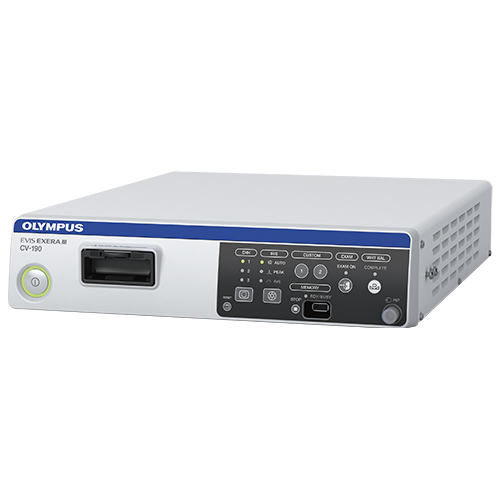Olympus Evis Exera III CV-190 Features
The Olympus Evis Exera III CV-190 video system center provides video processing for advanced endoscopy. The system enables easy access to the range of features in the Evis Exera III endoscopes. The New and improved image processing delivers outstanding image quality, thanks to reduced noise and halation along with improved color contrast for optimal image quality.
- NBI (Narrow Band Imaging) in Evis Exera III 190 Series scopes provides twice the viewable distance of Evis Exera II 180 Series scopes and offers significantly brighter images.
- CV-190 features the ability to switch the point of focus between ‘near’ and ‘normal’ with the push of a button.
- Newly designed, waterproof one-touch connector enables a one-step connection to the light source and does not require a separate scope cable for the video processor.
- The pre-freeze function selects the clearest still image automatically saving time.
- The CV-190 is compatible with EVIS 100/130/140/150 Series, EVIS EXERA 160 Series, EVIS EVERA II 180 Series, GI/BF/ VISERA Series scopes, and EVIS EXERA III 190 Series.
Olympus Evis Exera III CV-190 Specifications
Dimensions
- Height: 3.6” (9.1 cm)
- Width: 15” (38.2 cm)
- Depth: 19.3” (48.9 cm)
- Weight: 23.6 lbs (10.7 kg)
Power Supply
- Voltage: 100-240 V AC (NTSC)/220-240 V AC (PAL); within ±10%
- Frequency: 50/60 Hz; within ±1 Hz
- Consumption Electric Power: 150 VA
Portable Memory
- Media: MAJ-1925 (OLYMPUS)
- Recording Format: TIFF: no compression; JPEG (1/5): approx. 1/5 compression; JPEG (1/10): approx. 1/10 compression
- Number of Recorded Images: TIFF: approx. 227 images; JPEG (1/5): approx. 1024 images; JPEG (1/10): approx. 2048 images
Memory Backup
- User settings: Up to 20 user settings can be registered.
- Memorization of Selected Setting: The following settings are held in memory even after the video system center is turned off: Color tone; Iris mode; Enhancement; Color-enhancement mode; Contrast; AGC; Color mode; White balance
- Lithium battery Life: 5 years
Documentation
- Patient Data: The following data can be displayed on the monitor using the keyboard: Patient ID; Patient name; Sex; Age; Date of birth; Date of recording (time, stopwatch); Comments
- Displaying the Record State: The recording state of the following ancillary equipment can be displayed on the monitor: Portable memory and internal buffer; DVR; Video printer; Image filing system
- Displaying the image information: The following data can be displayed on the monitor: Structure-enhancement level; Edge-enhancement level; Zoom ratio; Color mode; Focus
- Advance Registration of Patient Data: Data for up to 50 patients can be registered, such as: Patient ID; Patient name; Sex and age; Date of birth
Observation
- Analog HDTV Signal Output: Either RGB (1080/60I: NTSC)/(1080/50I: PAL) or YPbPr (1080/60I: NTSC)/(1080/50I: PAL) output can be selected.
- Analog SDTV Signal Output: VBS composite (480/60I: NTSC)/(576/50I: PAL), Y/C (480/60I: NTSC)/(576/50I: PAL), and RGB (480/60I: NTSC)/(576/50I: PAL); simultaneous outputs possible
- Digital Signal Output: HD-SDI (SMTPE 292M), SD-SDI (SMPTE 259M), DV (IEEE 1394), and DVI (WUXGA, 1080p or SXGA) can be selected.
- White Balance Adjustment: White balance adjustment is possible using the white balance button on the front panel.
- Standard Color Chart Output: The “Color bar” or the “50% white” screen can be displayed.
- Color Tone Adjustment: The following color tone adjustments are possible using the color-tone-level adjustment button and color-tone selector button on the keyboard: Red adjustment: ±8 steps; Blue adjustment: ±8 steps; Chroma adjustment: ±8 steps
- Automatic gain control (AGC): The image can be electronically amplified when the light is inadequate due to the distal end of the endoscope being too far from the object.
- Contrast: N (Normal): Normal image; H (High): The dark areas are darker and the bright areas are brighter than in the normal image.; L (Low): The dark areas are brighter and bright areas are darker than in the normal image.
- Iris: The auto iris modes can be selected using the “iris mode” switch on the front panel.
- Auto: The brightness is adjusted based on the brightest part of the central part and the average brightness of the periphery part.
- Peak: The brightness is adjusted based on the brightest part of the endoscopic image.
- Average: The brightness is adjusted based on the average brightness of the endoscopic image.
- Image Enhancement Setting: Fine patterns or edges in the endoscopic images can be enhanced electronically to increase the image sharpness. Either the structural enhancement or edge enhancement can be selected according to the user setup. Structural enhancement: Enhancement of contrast of the fine patterns in the image; Edge enhancement: Enhancement of edges of the endoscopic image
- Switching the Enhancement Modes: The enhancement level can be selected from 4 levels (off, 1, 2, and 3) using the image enhancement mode button on the front panel.
- Image Size Selection: The size of the endoscopic image can be changed using the “IMAGE SIZE” key on the keyboard.
- Freeze: An endoscopic image is frozen using a «FREEZE» key on the endoscope or on the system keyboard.
- Switching the Method of Freezing the Endoscopic Image: Pre-freezing: The image with the least blur is selected and displayed from the images captured in the set time period before the freeze operation.
- Fog-free Function: When a compatible endoscope is connected to the video system center, the fog-free function can be used.
- Endoscope’s Remote Switches Function: The functions of the remote switches on the endoscope can be set in the user settings.
- Reset to defaults: The following settings can be reset to their defaults using the reset button on the front panel: Color tone; Iris mode; Image-enhancement mode; Color-enhancement mode; Optical-digital observation; Image size; Contrast; Freeze; Release index; Electronic zoom; Arrow pointer; Stopwatch; Characters on screen; PIP/POP
- Remote Control: The following ancillary equipment can be controlled (specified models only): Monitor; DVR; Video printer; Image filing system

